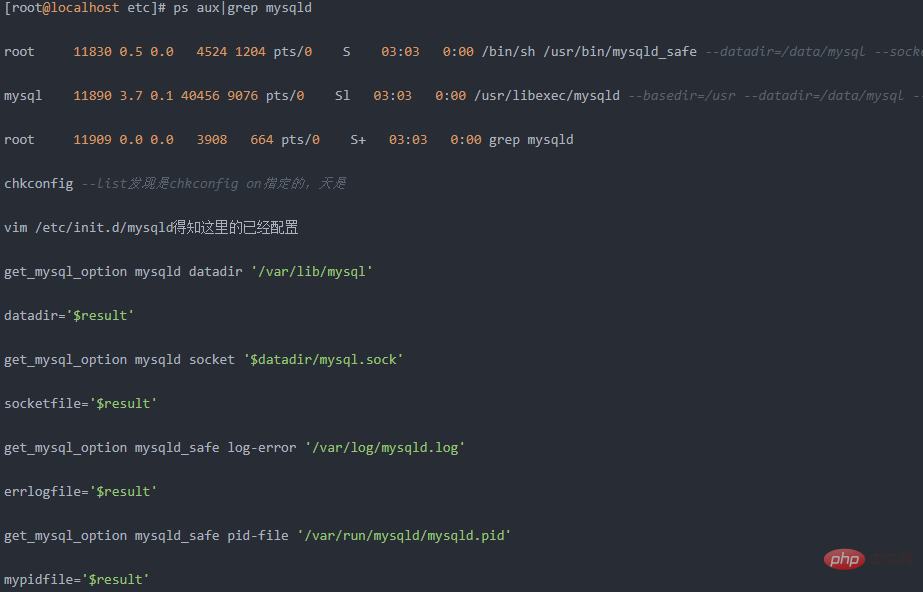Where is the log file in mysql
In mysql, log files are generally stored in the "/var/log/" directory; you can use the "show master status" statement to view the current log file, or you can modify the mysqld log in the configuration file related content to modify the location where the log file is stored.

The operating environment of this tutorial: windows10 system, mysql8.0.22 version, Dell G3 computer.
Where are the log files in mysql?
Log files mainly include error log files, binary log files, slow query log files, query log files, redo log files, etc.
MySQL logs are generally saved in the /var/log/ directory, but you need to look at the specific configuration file to determine. The specific method is as follows:
1. First log in to mysql: >mysql -u root -p
2. Then check whether the log is enabled mysql>show variables like 'log_%';
3. Check the current log mysql> show master status;
4. You need Known mysql log types: Error log: -log-err
Query log: -log
Slow query log: -log- slow-queries
Update log: -log-update
Binary log: -log-bin
5. Modify the configuration /etc/my.cnf (the following is the log file storage location) [mysqld]
log=/var/log/mysqld_common.log log-error=/var/log/mysqld_err.log log-bin=/var/log/mysqld_bin.bin
Expand knowledge:
Below This article gives a detailed introduction to mssql log files. If you are interested in mysql log files, you may wish to take a look.
1. Error Log Error Log
The error log records all serious warnings and error messages during the operation of mysql server, as well as detailed information about each startup and shutdown of mysql.
To enable the method, add the --log-error option when starting mysql. The error log is placed in the data directory by default and is named hostname.err. However, you can use the command --log-error[=file_name] to modify the storage directory and file name.
Sometimes, you want to back up the error log and restart recording. Use the flush logs command to backup the file ending in .old.
2. Binary log: Binary Log&Binary Log Index
is often referred to as binlog, which is one of the most important logs in mysql. After turning on the logging function through --log-bin[=file_name], mysql will record all queries that modify database data into the log file in binary form, including the execution time and resources consumed by each query. , and related transaction information. If file_name is not specified, it will be recorded as mysql-bin.**** in the data directory.
Binlog also has some other additional option parameters:
--max_binlog_size sets the maximum storage limit of binlog. When the log reaches this limit, a file will be re-created. Record.
--binlog-do-db=db_name parameter tells mysql to only log binlog to a certain database
--binlog-ignore-db The =db_name parameter tells mysql to ignore binlog records for a certain database
3. Update log: update log
Not supported after mysql5.0, similar to binlog, but not Recorded in binary form, it is a simple text format record
4. Query log: query log
Query log records all queries in mysql, which can be opened through --log[=file_name] Since this log records all queries, it is large in size and has a great impact on performance after being turned on. This function is only turned on briefly when tracking some special query performance issues. The default file name is hostname.log.
5. Slow query log: slow query log
Use --log-slow-queries[=file_name] to turn on this function and set the recording location and file name. The default file name is: hostname -slow.log, the default directory is also the data directory.
6.InnoDB’s online REDO log: InnoDB REDO Log
The REDO log records all physical changes and transaction information made by InnoDB. Through REDO logs and UNDO information, InnoDB ensures Transaction security under all circumstances. InnoDB's REDO log is also stored in the data directory by default. You can change the storage location of the log through innodb_log_group_home_dir. Set the number of logs through innodb_log_files_in_group.
How to modify the location of the MYSQL database log file?
I believe everyone knows a lot about MySQL log files. MySQL log files are generally located at:/var/log/mysqld.log. The following will teach you how to modify the location of the MySQL log file for your reference.
Today I need to change the location of the MySQL log file, but I found that it cannot be changed in /etc/my.cnf.
Later I discovered that the MySQL log bit is specified:

Recommended learning: mysql video tutorial
The above is the detailed content of Where is the log file in mysql. For more information, please follow other related articles on the PHP Chinese website!

Hot AI Tools

Undresser.AI Undress
AI-powered app for creating realistic nude photos

AI Clothes Remover
Online AI tool for removing clothes from photos.

Undress AI Tool
Undress images for free

Clothoff.io
AI clothes remover

Video Face Swap
Swap faces in any video effortlessly with our completely free AI face swap tool!

Hot Article

Hot Tools

Notepad++7.3.1
Easy-to-use and free code editor

SublimeText3 Chinese version
Chinese version, very easy to use

Zend Studio 13.0.1
Powerful PHP integrated development environment

Dreamweaver CS6
Visual web development tools

SublimeText3 Mac version
God-level code editing software (SublimeText3)

Hot Topics
 1667
1667
 14
14
 1426
1426
 52
52
 1328
1328
 25
25
 1273
1273
 29
29
 1255
1255
 24
24
 Laravel Introduction Example
Apr 18, 2025 pm 12:45 PM
Laravel Introduction Example
Apr 18, 2025 pm 12:45 PM
Laravel is a PHP framework for easy building of web applications. It provides a range of powerful features including: Installation: Install the Laravel CLI globally with Composer and create applications in the project directory. Routing: Define the relationship between the URL and the handler in routes/web.php. View: Create a view in resources/views to render the application's interface. Database Integration: Provides out-of-the-box integration with databases such as MySQL and uses migration to create and modify tables. Model and Controller: The model represents the database entity and the controller processes HTTP requests.
 MySQL and phpMyAdmin: Core Features and Functions
Apr 22, 2025 am 12:12 AM
MySQL and phpMyAdmin: Core Features and Functions
Apr 22, 2025 am 12:12 AM
MySQL and phpMyAdmin are powerful database management tools. 1) MySQL is used to create databases and tables, and to execute DML and SQL queries. 2) phpMyAdmin provides an intuitive interface for database management, table structure management, data operations and user permission management.
 MySQL vs. Other Programming Languages: A Comparison
Apr 19, 2025 am 12:22 AM
MySQL vs. Other Programming Languages: A Comparison
Apr 19, 2025 am 12:22 AM
Compared with other programming languages, MySQL is mainly used to store and manage data, while other languages such as Python, Java, and C are used for logical processing and application development. MySQL is known for its high performance, scalability and cross-platform support, suitable for data management needs, while other languages have advantages in their respective fields such as data analytics, enterprise applications, and system programming.
 Solve database connection problem: a practical case of using minii/db library
Apr 18, 2025 am 07:09 AM
Solve database connection problem: a practical case of using minii/db library
Apr 18, 2025 am 07:09 AM
I encountered a tricky problem when developing a small application: the need to quickly integrate a lightweight database operation library. After trying multiple libraries, I found that they either have too much functionality or are not very compatible. Eventually, I found minii/db, a simplified version based on Yii2 that solved my problem perfectly.
 Laravel framework installation method
Apr 18, 2025 pm 12:54 PM
Laravel framework installation method
Apr 18, 2025 pm 12:54 PM
Article summary: This article provides detailed step-by-step instructions to guide readers on how to easily install the Laravel framework. Laravel is a powerful PHP framework that speeds up the development process of web applications. This tutorial covers the installation process from system requirements to configuring databases and setting up routing. By following these steps, readers can quickly and efficiently lay a solid foundation for their Laravel project.
 Solve MySQL mode problem: The experience of using the TheliaMySQLModesChecker module
Apr 18, 2025 am 08:42 AM
Solve MySQL mode problem: The experience of using the TheliaMySQLModesChecker module
Apr 18, 2025 am 08:42 AM
When developing an e-commerce website using Thelia, I encountered a tricky problem: MySQL mode is not set properly, causing some features to not function properly. After some exploration, I found a module called TheliaMySQLModesChecker, which is able to automatically fix the MySQL pattern required by Thelia, completely solving my troubles.
 Explain the purpose of foreign keys in MySQL.
Apr 25, 2025 am 12:17 AM
Explain the purpose of foreign keys in MySQL.
Apr 25, 2025 am 12:17 AM
In MySQL, the function of foreign keys is to establish the relationship between tables and ensure the consistency and integrity of the data. Foreign keys maintain the effectiveness of data through reference integrity checks and cascading operations. Pay attention to performance optimization and avoid common errors when using them.
 Compare and contrast MySQL and MariaDB.
Apr 26, 2025 am 12:08 AM
Compare and contrast MySQL and MariaDB.
Apr 26, 2025 am 12:08 AM
The main difference between MySQL and MariaDB is performance, functionality and license: 1. MySQL is developed by Oracle, and MariaDB is its fork. 2. MariaDB may perform better in high load environments. 3.MariaDB provides more storage engines and functions. 4.MySQL adopts a dual license, and MariaDB is completely open source. The existing infrastructure, performance requirements, functional requirements and license costs should be taken into account when choosing.




